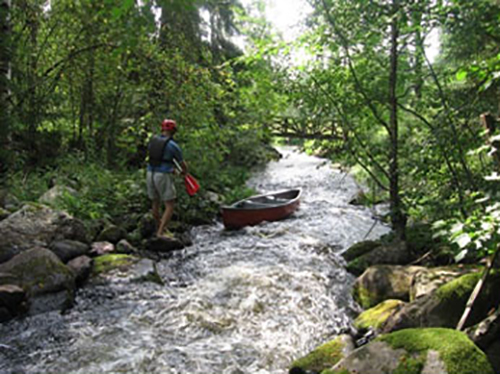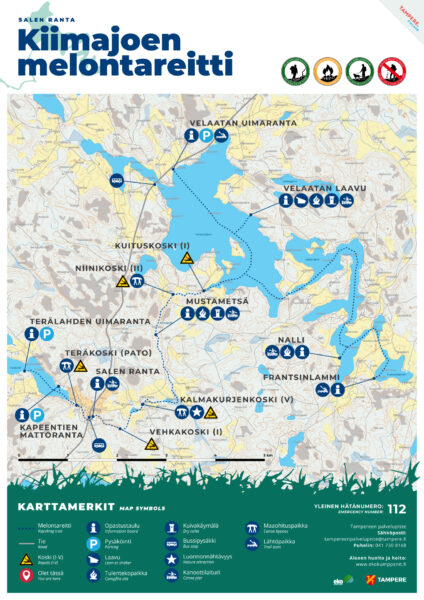Kiimajoki canoeing route
Lis
- Kiimajoki
- Routes and services
- Location and arrival
- Maps
- History
Kiimajoki
The Kiimajoki canoeing route is located in North Tampere in the landscapes of Velata and Terälahti. The historic swimming route follows the Kiimajoki downstream after Velaattajärvi and finally ends up in Näsijärvi’s Terälahti. The route runs along Velaattajärvi in a chain of several lakes and the total length of the route is about 17 kilometers. Along the route, there are several well-maintained landing and resting places.
Along the Kiimajoki canoeing route, there are several shelters and places to take a break. The newest destination is the Velaata laavu on the north shore of Velaattajärvi. The loggia was designed by architect Manu Humppi and the loggia offers a wonderful view of the sunny Velaattajärvi. Other rest stops on the route include e.g. Nallinranta and Mustametsä fireplaces. There are fireplaces and firewood at the sites, and some sites also have dry toilets.
The Kiimajoki paddling route has been renovated in 2021 and at its best it can be paddled in spring and autumn during high water.
Routes and services
Along Kiimajoki there are several rapids that you can pass along the banks. Landing sites at rapids are marked with traffic signs and structures have been built at the landing sites to facilitate landing. Familiarize yourself with the rapid classifications of the route in advance in the route description.

Destinations
Frantsinlammi
Facilities: Canoe pier, Information board
Nalli
Facilities: Campfire site, Woodshed, Canoe pier, Information board
Velaatta lean-to shelter
Facilities: Lean-to shelter, Campfire site, Woodshed, Dry toilet, Canoe pier, Information board
P1 Velaatta beach
Facilities: Canoe pier, Parking, Information board
Mustametsä
Facilities: Campfire site, Woodshed, Dry toilet, Canoe pier, Information board
Kalmankurjenkoski
Facilities: Land bypass site
Sale's beach
Facilities: Canoe pier, Information board
Teräkoski
Facilities: Dam, Land bypass site
P2 Kapeentien mattoranta
Facilities: Parking, Information board
P3 Terälahti beach
Facilities: Parking, Information board
Location and arrival
The canoeing destination is most easily accessible from Velata’s boat launch at Velaatantie 518, 34270 Tampere. Other starting points can be found on the map of the Kiimajoki canoeing route.Kartat

Kiimajoen melontareitti (TRE_L201 – pdf)
See more map information in the link Hiking map in the upper left corner.
History
The need to transport wood was accelerated by the construction of Tampere from the 18th century and the birth of the sawmill industry in Finland from the 19th century. The Kiimajoki route is the headwaters of the Kokemäenjoki watershed. The wood could be floated to Pori and from there shipped from Reposaari to the world. During the winter, the trees were cut down from the forest and driven to the beach to wait for the ice to leave. The trees were transported across the lake in rafts, but in the narrows the rafts always had to be unloaded. So there was enough work for the whole trip.
Kiimajoki stream crossing had to be done in the spring when there was plenty of water. It is said that the flotation managers of different companies fought over the first flotation shifts, even over cookies. The stream crossings were usually done by Pentecost.
Frantsinlampi got its name from the farm Frantsi, which has been known since at least the 17th century. Of the farm’s old buildings, only a shed remains. The place of the departure pier is called Tiililahti, which tells about the manufacturing of bricks there.
Frantsi’s farm is currently owned by the Tampere branch of the Mannerheim Children’s Protection Association. The Frantsinlammi departure pier is located on state land. Information about Nalli’s estate can be found in documents from the 16th century.
The latest buildings on the farm were built in the 1950s. There is a special type of vegetation in the yard of Nalli’s house. Ilmari Blomqvist, head of the timber company Enqvist, which hosted the house in the 1950s, planted e.g. tujan, sembra pine and oak. Sembras can be seen on the canoe shore behind the field at the edge of the forest. There is a lot of old traditional garden vegetation near the main building. Nalli’s farm is currently privately owned. The buildings have recently been rented out. The fields are managed by a local farmer. Continuous cultivation is necessary to maintain an open cultural landscape.
A mill, a sawmill and a dairy have operated in Niinikoski. The waterfall has been such an important factor in the life of the villages that the use of its water for various purposes has been regulated according to the instructions of the officials of the Imperial Senate: If the water was low, the support mowing had to be started first, then the dairy and finally the sawmill.
A road connecting the villages crossed the river near the rapids – after all, you had to be able to do business in the establishments run by the rapids from either bank. All that remains of the buildings is the last miller’s house, which is a private residence.
Kalmakurjenkoski
The first written information about the Kalmakurje mill can be found in the mill inspection documents of 1649. There were two mills at that time. From the year 1784 there is a mention that the Kalmakurje mills were running almost all year round.
In the years 1850-1923, the own sect or “lahhoon” mill operated in Kalmakurje. A new mill building was built on the south shore of the waterfall in 1924-25. From the 19th century to the 1950s, the rapids had a wooden chute intended for guiding the logs, for log harvesting that continued through the rapids.
In the 20th century, an electricity plant also operated for a while in Kalmakurje rapids. Currently, the mill plot on the northern shore is owned by the Mattila family, and the buildings have been bequeathed to Teisko-Seura for museum activities. The Eteläranta mill is owned by the miller Niemen’s family.
All three of these parties have kindly given permission for kayakers to pass through the area.
Teräkoski sawmill’s establishment permit was obtained on 5 July 1831. The initiative to establish the sawmill came from Mattila of Kiimajoki and the other shareholders were Heikkilä of Terälahti and Teiskola manor. A saw was needed in Teisko, because at that time the nearest household saw was in Hatanpää, 3.5 penny corners away. Before this, the Iso-Mattila mill operated a little further down in Teräkoski. In the 1920s, the sawmill was run by the multi-skilled Ikonen brothers. Toivo, Väinö and Lauri. At that time, the wood of many companies passed through Teräkoski: Enqvist, Rosenlev, Serlachius, Elovaara, Leppälahti, Lielahti.
Sahan tienoo was the center of the village, especially after 1930, when an office building with a bank, post office, shop and telephone company, later also a library, was built next to it. On Teräkoski’s road, people met each other in all kinds of matters.
Romance also blossoms – When the Ikonen brothers were asked where they had found their wives, the answer was: “You can find wives in the store.” The lumber store run by the Ikonen family stopped operating in Teräkoski in the 1980s. The sawmill building is currently in residential use.
Along Kapeentie, on the north shore of Terälahti, the building of Jykevä Teisko Cooperative Meijer has been standing since 1925. In the past, there was a handsome pier in front of it, where ships came to bring milk and take dairy products to buyers. Tampere was often the destination. The dairy building is currently in private use.
Uitto
The need to transport wood was accelerated by the construction of Tampere from the 18th century and the birth of the sawmill industry in Finland from the 19th century. The Kiimajoki route is the headwaters of the Kokemäenjoki watershed. The wood could be floated to Pori and from there shipped from Reposaari to the world. During the winter, the trees were cut down from the forest and driven to the beach to wait for the ice to leave. The trees were transported across the lake in rafts, but in the narrows the rafts always had to be unloaded. So there was enough work for the whole trip.
Kiimajoki stream crossing had to be done in the spring when there was plenty of water. It is said that the flotation managers of different companies fought over the first flotation shifts, even over cookies. The stream crossings were usually done by Pentecost. From Terälahti, the log’s journey started in bigger waters towards Tampere and Pori. Through the port of Reposaari, wood traveled all the way to Central Europe.


